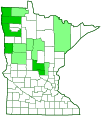Drummond’s campion
(Silene drummondii ssp. drummondii)
Conservation • Description • Habitat • Ecology • Use • Distribution • Taxonomy
Conservation Status |
|
|||||||
| IUCN Red List | not listed |
|||||||
| NatureServe | NNR - Unranked S3 - Vulnerable |
|||||||
| Minnesota | Special Concern |
|||||||
Description |
||
Drummond’s campion is a 8″ to 20″ tall, erect perennial, that rises on one or several stems from a branched, fleshy caudex atop a stout taproot. When young the plant forms a basal rosette of leaves. Later it sends up flowering stems. The stems are lanky and covered with fine, downward-pointing hairs top to bottom. Near the top they are sticky due to stalked glands. Leaves are mostly basal. The basal leaves are 1⅛″ to 4″ long including the leaf stalk, from less than ¼″ to ½″ wide, lance-shaped to elliptic or inversely lance-shaped with the attachment at the narrow end. They are covered with short, stiff hairs on the upper and lower surfaces. They are borne on leaf stalks. The margins are untoothed. There are 2 to 5 pairs of opposite leaves in the stem. Stem leaves are narrower, opposite, and usually linear. They are 1⅛″ to 3½″ long and ¼″ or less wide. They are covered with short, stiff hairs on the upper and lower surfaces. The margins are untoothed. The inflorescence is loose and narrow at the top of the stem, with 1 to 20, but usually 1 to 10, flowers. The sepals are fused at the base into a tube (calyx) terminating in 5 short, erect lobes. The calyx is narrowly ellipse-shaped, not inflated, 2 to 3 times as long as broad, ⅜″ to ⅔″ long when in flower, ½″ to ¾″ long and ⅛″ to ⅓″ wide when in fruit. It has 10 green major veins that are raised on the surface (prominent), forming ridges. They are covered with sticky, glandular hairs. The flowers have both male and female reproductive organs (perfect). The 5 petals are off-white to dusky pink, with a stalk-like narrow base (claw). They are as long as the calyx, and do not protrude from it, or are up to 1½ times as long as the calyx, and do protrude from it. There are 10 stamens that do not project beyond the calyx. There are 5, sometimes 4, styles that also do not project beyond the calyx. The fruit is a 3-chambered capsule the same size as the calyx the same size or, rarely, 1½ times as long as the calyx, with 5, sometimes 4, spreading teeth at the top. |
||
Height |
||
8″ to 20″ |
||
Flower Color |
||
Off-white to dusky pink |
||
Similar Species |
||
Habitat |
||
Dry. Prairies, hillsides. |
||
Ecology |
||
Flowering |
||
June |
||
Pests and Diseases |
||
|
||
Use |
||
|
||
Distribution |
||||
|
Sources 2, 3, 4, 5, 6, 28, 29, 30. Most of the habitats in Minnesota suitable for Drummond’s campion are on private land. There are five known populations on public property, all of which are on Wildlife Management Areas. The map at left shows current known populations on public property in dark green and all other records and sightings in light green. |
|||
| 2/22/2023 | ||||
Nativity |
||||
Native |
||||
Occurrence |
||||
Rare in Minnesota |
||||
Taxonomy |
|||
| Kingdom | Plantae (Plants) | ||
| Division | Tracheophyta (Vascular Plants) | ||
| Subdivision | Spermatophytina (Seed Plants) | ||
| Class | Magnoliopsida (Dicots) | ||
| Subclass | Caryophyllidae | ||
| Superorder | Caryophyllanae | ||
Order |
Caryophyllales (Pinks, Cactuses, and Allies) | ||
Family |
Caryophyllaceae (Pink) | ||
| Subfamily | Caryophylloideae | ||
| Tribe | Sileneae | ||
Genus |
Silene (catchflies) | ||
| Subgenus | Behenantha | ||
| Section | Physolychnis | ||
| Species | Silene drummondii (Drummond’s campion) | ||
Subordinate Taxa |
|||
There are two or three subspecies of Drummond’s campion are recognized in North America, depending on the source. Only ssp. drummondii occurs in Minnesota. |
|||
Synonyms |
|||
Gastrolychnis drummondii Lychnis drummondii Lychnis pudica Melandrium drummondii Silene drummondii var. drummondii Silene drummondii var. kruckebergii Wahlbergella drummondii |
|||
Common Names |
|||
Drummond catchfly Drummond’s campion Drummond’s catchfly |
|||
Glossary
Bract
Modified leaf at the base of a flower stalk, flower cluster, or inflorescence.
Calyx
The flower cup. May be the group of outer floral leaves (sepals) collectively, or a tube with lobes.
Caudex
A short, thickened, woody, persistent enlargement of the stem, at or below ground level, used for water storage.
Claw
A stalk-like narrowed base of some petals and sepals.
Glandular hairs
Hairs spread over aerial vegetation that secrete essential oils. The oils act to protect against herbivores and pathogens or, when on a flower part, attract pollinators. The hairs have a sticky or oily feel.
Linear
Long, straight, and narrow, with more or less parallel sides, like a blade of grass.
Visitor Photos |
|||||
Share your photo of this plant. |
|||||
| This button not working for you? Simply email us at info@MinnesotaSeasons.com. Attach one or more photos and, if you like, a caption. |
|||||
|
|||||
MinnesotaSeasons.com Photos |
|||||
|
|||||

Slideshows |
||

Visitor Videos |
|||
Share your video of this plant. |
|||
| This button not working for you? Simply email us at info@MinnesotaSeasons.com. Attach a video, a YouTube link, or a cloud storage link. |
|||
Other Videos |
|||

Visitor Sightings |
|||||
Report a sighting of this plant. |
|||||
| This button not working for you? Simply email us at info@MinnesotaSeasons.com. Be sure to include a location. |
|||||
|
|||||
MinnesotaSeasons.com Sightings |
|||||
|
|||||

|
Created: Last Updated: © MinnesotaSeasons.com. All rights reserved. |
